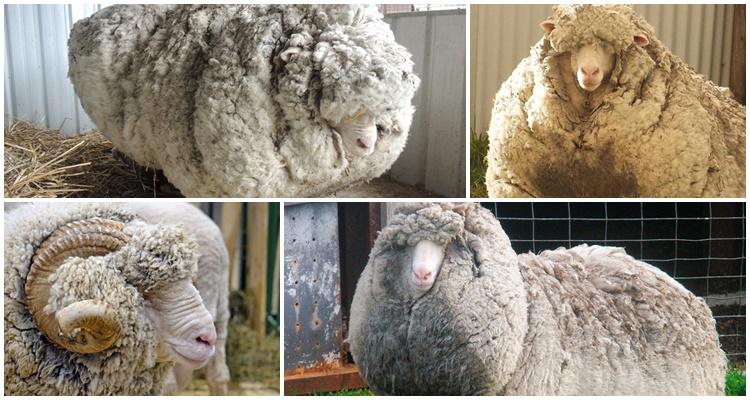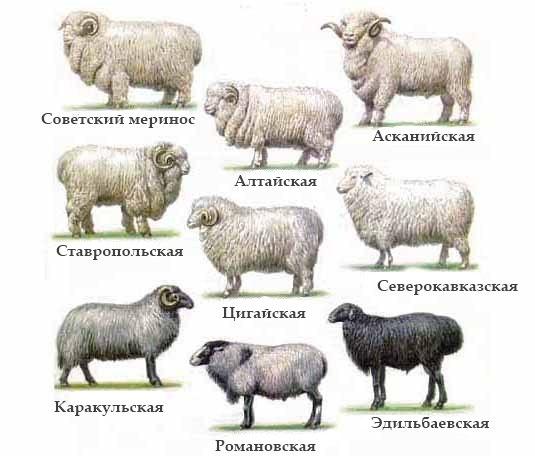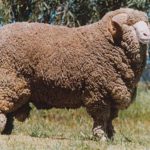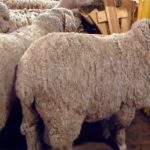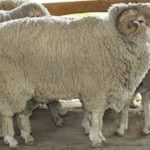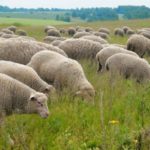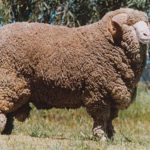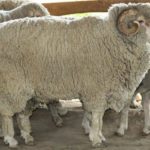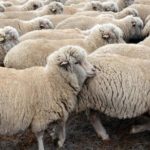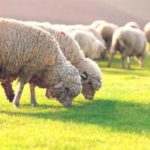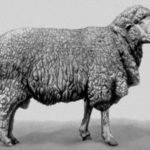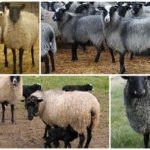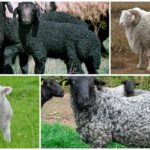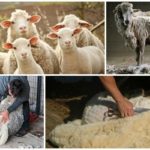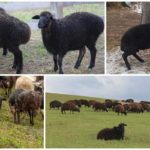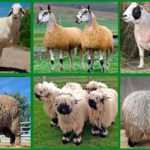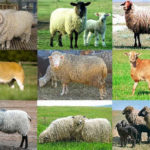The breed of valuable, fine-wool sheep has long been widespread in all corners of the globe. Pets continuously provide their owners with valuable fiber and tasty dietary meat. Picky animals easily put up with any living conditions and get used to unfavorable climates. Breeding fine-wool pets is traditionally considered a profitable business.
General characteristics of fine-wool sheep
The sheep variety is descended from its ancestors, the Merino sheep.Residents of Italy and Asia Minor successfully bred unpretentious pets for more than 1000 years, and in the mid-18th century the animals gained fame in other countries.
Today there are many breeds of fine-fleece animals. Each of them has its own characteristics, but the basic properties of valuable animals remain unchanged. The main advantage of pets is the ability to easily adapt to any climatic conditions. Animals have a well-developed skeletal system.
All individuals of fine-wool breeds have long, silky hair. Staple fibers have a wavy structure. Hair fineness is no more than 30 microns. The length of the strands does not exceed 10 cm. The animals secrete an impressive amount of grease. This substance contains lanolin.
Productivity
Curly-haired beauties are suppliers of soft and warm wool. The material is used to make clothing, insulation, pillows and blankets. Products made from webbing are especially valued. Lamb skins received this name many years ago. Precious offspring are produced by fine-fleece and semi-fine-fleece individuals. Animals are used as a source of meat and milk. Purebred pets are bred to develop new breeds and improve the qualities of native sheep.
Wool
The light wool of fine-wool sheep is uniform and mainly consists of fluff. The maximum fineness of valuable fiber is 25 microns. Pets are regularly groomed. The annual shearing of a fine-wooled animal depends on the breed of sheep. On average, rams produce up to 16 kg of fleece, and ewes - 7-8 kg.
Fertility
In order for sheep farming to be profitable, animals must actively reproduce.Young pets reach sexual maturity between 6 and 12 months. Pregnancy in animals lasts 146 days. If representatives of the fine-fleece sheep breed are able to give birth several times a year, the pregnancy period is reduced. At one time, a ewe can give birth to 1 to 3 lambs.
Types of breeds
Depending on their purpose, experts divide fine-fleece animals into 3 categories: wool, meat-wool (semi-fine-fleece) and meat animals.
Soviet merino
The breed developed in the first half of the 20th century. The ancestors of Soviet Merinos were New Caucasian and Mazaevsky sheep, as well as representatives of the Altai and Askanian breeds. The peculiarity of Soviet merino sheep is the division of animals into 2 varieties: wool and meat-wool individuals. Woolly pets are easily recognized by 2 transverse folds on the skin located in the neck area. In the same area of the body of meat-wool sheep there is only one long longitudinal fold. Soviet merino sheep are different:
- harmonious, proportional body build;
- powerful skeletal system;
- straight, massive limbs;
- impressive body weight (a ram weighs 100-110 kg, a ewe - 50-55 kg);
- thick, dense, snow-white hair covering the entire body of the animal.
Males bring up to 16 kg of fleece per year. 6-7 kg of wool, 64-70 quality class, is sheared from the ewes. After wet cleaning, the yield of raw materials is 40%.
Sal sheep
Sal sheep appeared as a result of the work of Soviet specialists. Scientists managed to cross valuable sheep of the Rambouillet breed with New Caucasus and Mazaevsky rams.The animals are adapted to the warm climate of the Rostov region. Large animals have enviable endurance and strong immunity. Representatives of the Sal breed are characterized by:
- powerful physique;
- wide, expanded chest;
- elongated torso shape;
- the weight of a mature ram reaches 90-95 kg, the uterus – 50 kg;
- the presence in the neck area of 2 deep transverse and one long longitudinal folds.
Light strands of animal wool grow up to 7-8 cm. Every year 16 kg of raw material is sheared from rams, and up to 7 kg from sheep. Staple fleece extracted from queens is estimated at grade 70. Males give wool level 64.
Stavropolskaya
Stavropol wool sheep appeared in the 50s of the last century. To develop a new breed, local animals were crossed with Australian merino sheep, Ramboulier rams and representatives of New Caucasian sheep species. Stavropol pets are characterized by:
- Small growth. One-year-old rams hardly grow to 62 cm; the females are a little more modest in size.
- Developed, strong skeletal system.
- Slightly drooping croup and wide loin area.
- The average weight of a ram reaches 95-100 kg, the female gains 45-50 kg.
- The strong neck is decorated with a couple of folds. Rams have horns.
Stavropol sheep are record holders for growing a large amount of soft wool. The length of the snow-white strands reaches 9-11 cm. The areas of the pet’s abdomen, head and limbs are especially heavily overgrown. Every year, more than 15 kg of excellent wool is obtained from each ram; up to 8 kg of raw material is sheared from a ewe.After wet processing, the net wool yield is 43%. Thick, delicate fleece belongs to quality grade 64-70.
South Ural sheep
The homeland of South Ural sheep is the Orenburg region. Experts have improved the local variety of coarse-haired animals with the help of Prekos rams, as well as pets of the Tsigai and Stavropol breeds.
Individuals are well adapted to harsh climatic conditions. Pets are able to get food even under a layer of snow. Meat and wool South Ural sheep are distinguished by:
- powerful physique;
- rounded body contours;
- the presence of a “beard” in the neck area;
- impressive weight (ram weight - 120 kg, sheep weight - 65 kg);
- good quality wool. The length of the highly crimped strands reaches 9 cm. The quality mark is 60-64 degrees. After processing, the net yield of raw materials is 50%.
The breed is famous for its high quality meat. The product has a delicate, refined taste and is almost completely devoid of a specific smell. Animals are growing rapidly and actively gaining weight.
Sheep prekos
Animals of the Precos breed appeared thanks to French specialists. Breeders crossed fine-wooled English Merino sheep with Ramboulier sheep. Representatives of the meat-and-wool type of sheep are loved by livestock farmers from the southern regions of the country, so they can be found on many farms.Thanks to the special structure of their hooves, pets move freely along the slopes of hills.
Prekos are characterized by:
- smooth, straight back;
- well-developed muscles;
- massive bones;
- widely spaced limbs;
- the average weight for males is 82-100 kg, for females - 52-68 kg.
- the head and limbs are free from hair;
- the length of snow-white strands is 10 cm, and the quality indicator is 60-64 degree.
In 1 year, 8-9 kg of precious wool is sheared from a ram. The uterus produces 4-5 kg of raw materials. The net fiber yield after processing (washing) is 50%. Prekos are fertile - in half of the births, females give birth to 2 lambs. The main advantages of the Prekos breed are the rapid maturation of young animals and excellent quality of meat. By the age of 9 months, animals gain weight and are sent to slaughter.
Kazakh fine wool breed
As a result of crossing local fat-tailed animals with pets of the Prekos breed, Australian Merinos and Rambouliers, the Kazakh fine-wool sheep was born.
Representatives of the breed are characterized by:
- tightly built, elongated body;
- impressive weight (male – 100-116 kg, female – 60-70 kg);
- The curly pet's height reaches 75 cm.
Polled Kazakh sheep are reliable suppliers of silky light beige wool. Each male is sheared up to 12 kg of raw material, females produce no more than 5-6 kg of wool. The hair thickness is 19.5-20.5 microns. The quality level of the strands is 64-70. Every year the pet gives its owners 152 liters of fat milk (up to 9%).
Sheep spend time on pasture all year round.The animals are distinguished by their rare endurance and can easily endure sweltering heat and frost. Pets are not picky about food. Even with a meager diet, curly-haired beauties easily gain weight.
Which one is better to choose?
The choice of animal breed depends on climatic conditions and the geographical location of the farm. It is recommended to pay attention to unpretentious and hardy crosses. Such animals are born from representatives of different breeds. Among purebred individuals, Merinos are highly productive.
Pets are known as a source of quality wool. One of the varieties of the Merino breed came to Russian livestock breeders from Australia.
Maintenance and care
In winter, pets are kept in a common room. Any spacious, ventilated building is suitable for these purposes. Sheep with small lambs are isolated in separate stalls. The pets' winter diet consists of hay, corn silage and root vegetables. Salt must be placed in the feeders, and clean water is poured into the drinking bowls.
In warm weather, animals are sent to pasture. There should be several areas, because pets eat the grass cover to the very roots. By alternating grazing areas, livestock farmers allow the vegetation to recover. At night, the animals are kept under a canopy. Periodically, pets have their hooves trimmed, overgrown hair trimmed, and treated against helminths.

